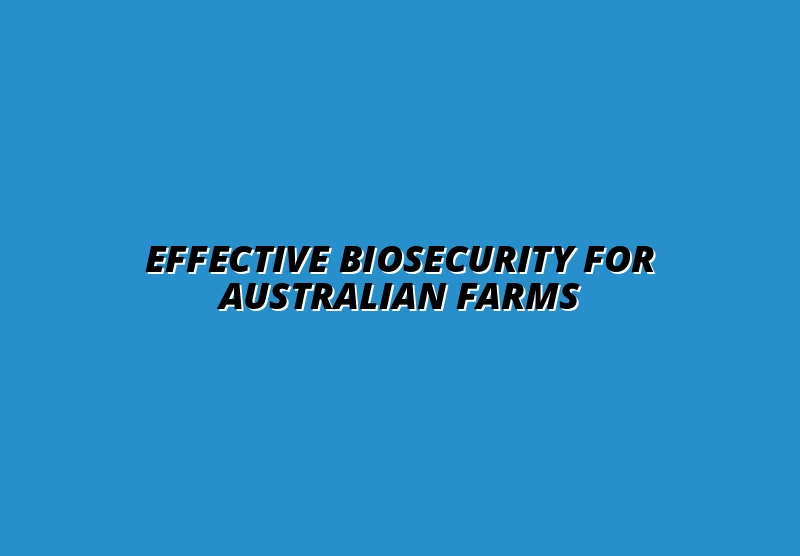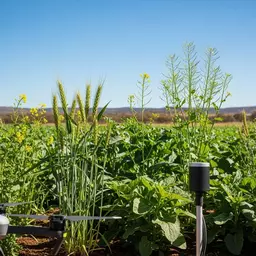Effective Biosecurity for Australian Farms

As Australia faces growing agricultural challenges, the significance of biosecurity cannot be overstated. With effective measures, farmers can not only protect their livelihoods but also contribute to the sustainability of our food systems. Let’s delve into the key lessons from this essential topic.
What You Will Learn
- Biosecurity is crucial for preventing pest and disease outbreaks that threaten crops and livestock.
- Understanding key legislation, such as the Biosecurity Act 2015, is essential for effective biosecurity management.
- Investing in biosecurity measures can lead to significant economic benefits, including reduced losses and improved market access.
- Non-compliance with biosecurity protocols can result in severe financial risks, including fines and damage to reputation.
- Leveraging technology, such as IoT and data analytics, can enhance biosecurity monitoring and response efforts.
- Real-world case studies demonstrate the successful implementation of biosecurity practices, leading to sustainable agricultural outcomes.
Australian Biosecurity Framework: Legislation & Impact
This visual outlines the key legislative foundations and the critical cost-benefit factors in Australian biosecurity, showing how robust frameworks lead to economic and environmental resilience. For a deeper understanding of these frameworks, you can explore understanding biosecurity in Australia.
Key Biosecurity Legislation
- ● Biosecurity Act 2015: Foundation for management, protocols, and responsibilities.
- ● Quarantine Act 1908: Addresses movement of goods and animals across borders.
- ● Various State Acts: Specify local requirements and procedures.
Economic Impact & Benefits
- ★ Cost Savings: Prevents costly disease outbreaks.
- ★ Market Access: Compliance for lucrative export opportunities.
- ★ Reduced Premiums: Lower insurance costs by mitigating risks.
- ★ Improved Productivity: Healthier crops & livestock yield better returns.
Understanding Biosecurity: A Necessity for Australian Farms and Plant Industries
At Plant Frontier Insights, we recognize that biosecurity is not just a buzzword; it’s a critical component of sustainable agriculture in Australia. Biosecurity measures protect our farms from pests and diseases that can devastate crops and livestock. As we face the increasing challenges posed by climate change and globalization, ensuring robust biosecurity practices is more important than ever!

Implementing effective biosecurity not only safeguards our agricultural resources but also supports the economic viability of our farming communities. By understanding the significance of biosecurity, farmers can better protect their livelihoods and contribute to the resilience of Australia's food systems.
The Importance of Biosecurity in Agriculture
Biosecurity plays a vital role in maintaining the health of our crops and livestock. Its importance can be summarized in several key points:
- Prevention of Pest and Disease Outbreaks: Effective biosecurity measures help prevent the introduction and spread of pests and diseases.
- Protection of Natural Ecosystems: By managing risks, biosecurity practices help maintain biodiversity and ecological balance.
- Economic Stability: Healthy plants and livestock lead to better yields, ensuring food security and profitability for farmers.
As we delve deeper into biosecurity practices, it's clear that they are essential to preserving both agricultural productivity and environmental health. Implementing these practices can enhance the resilience of our agricultural systems, ensuring they withstand various threats, including those related to sustainable pest control in Australia.
Key Legislation Governing Biosecurity in Australia
Australia's approach to biosecurity is supported by a comprehensive legal framework designed to protect agricultural interests. The following are the cornerstone pieces of legislation that shape our biosecurity landscape:
- Biosecurity Act 2015: This act provides the foundation for biosecurity management in Australia, outlining responsibilities and protocols.
- Quarantine Act 1908: This older legislation complements the Biosecurity Act by addressing the movement of goods and animals across borders.
- Various State Acts: Each state has its own biosecurity laws that further specify local requirements and procedures.
Understanding these laws is crucial for farmers and industry stakeholders, as compliance ensures that biosecurity measures are effectively implemented and that our agricultural systems remain protected.
Overview of the Biosecurity Act 2015
The Biosecurity Act 2015 serves as a comprehensive framework for managing biosecurity risks across Australia. It emphasizes the importance of risk management and emphasizes shared responsibility among various stakeholders, including farmers, researchers, and policymakers. Under this act, several key features are highlighted:
- Risk Assessment: The act requires rigorous assessment of potential risks associated with pests and diseases.
- Emergency Response: It outlines procedures for responding to biosecurity emergencies, ensuring rapid action when outbreaks occur.
- Compliance Requirements: Farmers and businesses must adhere to specific guidelines to minimize biosecurity breaches.
This legislation is a powerful tool that empowers us to create a safer agricultural environment. By familiarizing ourselves with its provisions, we can enhance our biosecurity practices and contribute to a more resilient agricultural sector.
We Want to Hear From You!
What do you think about the role of technology in enhancing biosecurity measures? Share your thoughts below:
Assessing the Economic Impact of Biosecurity Measures
Understanding the economic impact of biosecurity measures is critical for Australian farms and plant industries. Not only do these measures protect our agricultural systems, but they also play a vital role in ensuring the long-term sustainability of our food production. Investing in biosecurity can prevent costly disease outbreaks and enhance the overall resilience of our agricultural ecosystem.
When we analyze the costs involved, it's essential to consider both direct and indirect benefits. By implementing comprehensive biosecurity measures, farms can save on potential losses due to pest infestations or disease outbreaks. Thus, a detailed cost-benefit analysis becomes crucial in understanding the true value of these investments.

Cost-Benefit Analysis: Investing in Biosecurity for Long-Term Success
A thorough cost-benefit analysis helps gauge whether investing in biosecurity measures is worthwhile. Here are key factors to consider:
- Prevention of Disease Outbreaks: The costs associated with managing an outbreak can far exceed the initial investments in biosecurity.
- Market Access: Many markets demand strict biosecurity compliance, affecting access to lucrative export opportunities.
- Insurance Premiums: Effective biosecurity can lead to lower insurance premiums by mitigating risks.
- Improved Productivity: Healthier crops and livestock yield better returns on investment.
Evaluating these factors can provide farms with a clearer picture of how robust biosecurity practices contribute not only to their sustainability but also to their profitability.
Identifying Potential Financial Risks from Non-Compliance
Non-compliance with biosecurity measures can open the door to significant financial risks. The potential repercussions include:
- Fines and Penalties: Regulatory bodies enforce strict penalties for breaches in biosecurity protocols.
- Loss of Market Position: A bad reputation due to disease outbreaks can lead to lost customers.
- Increased Operational Costs: Dealing with an outbreak can lead to higher costs for emergency measures and loss of productivity.
- Long-Term Recovery Costs: Rebuilding a farm's reputation and trust can take years and substantial investment.
By recognizing these risks, farms can prioritize compliance and develop proactive strategies that safeguard their financial health.
Leveraging Technology for Effective Biosecurity Monitoring
In today's digital world, technology plays an increasingly vital role in enhancing biosecurity measures. Leveraging digital tools and Internet of Things (IoT) solutions allows farms to monitor potential biosecurity threats effectively. Explore innovative biosecurity technologies in Australia to see how these advancements are being applied.
Emerging Digital Tools and IoT Solutions in Agriculture
As I explore the intersection of technology and agriculture, I've seen remarkable advancements that can significantly improve biosecurity. Some of the most promising emerging digital tools include:
- Remote Sensing: Utilizing drones and satellite imaging to monitor crop health and identify pest outbreaks early.
- Data Analytics: Advanced algorithms can predict pest behavior and disease spread, enabling targeted interventions.
- Mobile Applications: Apps that facilitate reporting and tracking disease symptoms in real-time enhance community engagement.
- IoT Sensors: Smart sensors in the field can provide continuous monitoring of environmental conditions that affect biosecurity.
Incorporating these tools not only enhances surveillance but also empowers farmers to make informed decisions swiftly.
Technology in Biosecurity: Enhancing Surveillance and Risk Mitigation
Integrating technology into biosecurity strategies can create a more resilient agricultural system. By enhancing surveillance and risk mitigation efforts, farms can:
- Streamline Monitoring: Automated systems reduce the burden of manual checks.
- Increase Accuracy: Data-driven decisions enhance the precision of pest control measures.
- Improve Communication: Sharing information quickly enhances collaboration among stakeholders.
These advancements ultimately lead to a more proactive approach to biosecurity, fostering a culture of readiness and resilience.
Case Studies of Successful Biosecurity Implementation
Real-world examples highlight the effectiveness of biosecurity measures. Here are notable case studies that showcase successful implementation:
- Australian Mango Industry: Adopted drone technology to monitor for fruit fly outbreaks, significantly reducing pest damages.
- Sheep Industry in Tasmania: Employed data analytics to track disease spread patterns, leading to timely intervention strategies.
- Vegetable Growers: Implemented mobile apps for real-time pest reporting, improving community response times.
These success stories demonstrate that investing in advanced biosecurity practices can yield substantial benefits, reinforcing the idea that we need to embrace innovation for a sustainable future.
Conclusion: The Way Forward for Australian Farms and Plant Industries
As we move forward, it is crucial to reinforce the importance of biosecurity compliance across all agricultural sectors. By fostering community engagement and awareness campaigns, we can enhance public understanding of biosecurity's value.
Let's work together to create robust biosecurity management plans that protect our agricultural legacy for generations to come!
Call to Action: Start building your biosecurity management plan today. Together, we can ensure a sustainable and resilient future for Australia’s farms and plant industries!
Recap of Key Points
Here is a quick recap of the important points discussed in the article:
- Importance of Biosecurity: Biosecurity measures prevent pest and disease outbreaks, protect natural ecosystems, and ensure economic stability for farmers.
- Key Legislation: Familiarity with the Biosecurity Act 2015 and other related laws is essential for compliance and effective biosecurity management.
- Economic Benefits: Investing in biosecurity can prevent costly outbreaks and improve market access, ultimately enhancing farm productivity.
- Financial Risks of Non-Compliance: Non-compliance can lead to fines, loss of market position, and increased operational costs.
- Technology Integration: Utilizing emerging digital tools and IoT solutions can enhance surveillance and proactive risk management in biosecurity.
- Successful Case Studies: Real-world examples demonstrate the effectiveness of advanced biosecurity measures in various agricultural sectors.
Frequently Asked Questions (FAQs)
- What is biosecurity in the context of Australian agriculture?
Biosecurity refers to measures taken to prevent the introduction and spread of pests and diseases that could harm crops, livestock, and natural ecosystems in Australia. It's crucial for protecting farmer livelihoods and ensuring food system sustainability. - Which key legislation governs biosecurity in Australia?
The primary legislation is the Biosecurity Act 2015, which provides the framework for management, protocols, and responsibilities. The Quarantine Act 1908 also addresses cross-border movement, and various State Acts specify local requirements. - What are the economic benefits of investing in biosecurity?
Economic benefits include cost savings from preventing costly disease outbreaks, improved market access due to compliance, reduced insurance premiums, and enhanced productivity from healthier crops and livestock. - What are the financial risks of non-compliance with biosecurity protocols?
Non-compliance can lead to significant financial risks such as fines and penalties from regulatory bodies, loss of market position due to damaged reputation, increased operational costs for managing outbreaks, and long-term recovery costs. - How is technology being used to enhance biosecurity monitoring?
Technology, including remote sensing (drones, satellite imaging), data analytics, mobile applications, and IoT sensors, is used to streamline monitoring, increase data accuracy, predict pest behavior, and improve communication for rapid intervention.
Popular Posts
 As the agricultural landscape in Australia evolves, the role of genetic innovation tools becomes inc
As the agricultural landscape in Australia evolves, the role of genetic innovation tools becomes inc
 As the agricultural landscape in Australia faces mounting challenges, understanding effective crop p
As the agricultural landscape in Australia faces mounting challenges, understanding effective crop p
 As Australia faces growing agricultural challenges, the significance of biosecurity cannot be overst
As Australia faces growing agricultural challenges, the significance of biosecurity cannot be overst
 As we delve into the intricate world of biosecurity, consider this: the health of Australia’s ecos
As we delve into the intricate world of biosecurity, consider this: the health of Australia’s ecos
